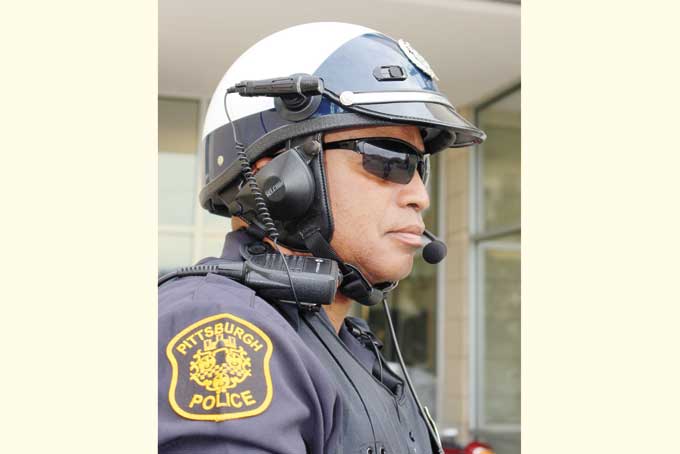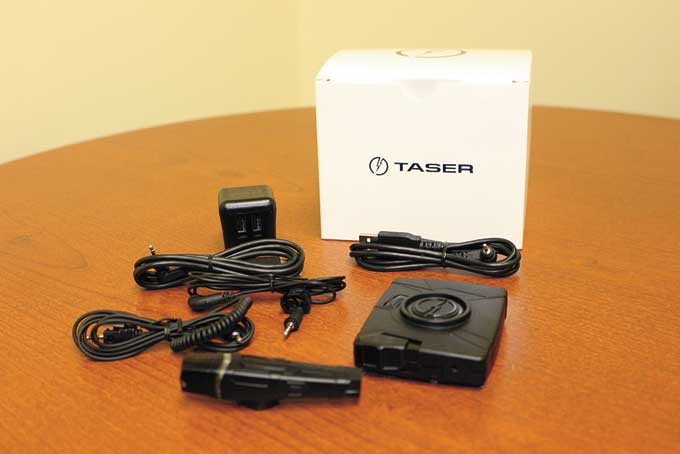
On Pittsburgh police Lt. Clarence “Ed” Trapp’s desk is a large, mostly-empty pretzel jar. And not far away on the floor is also a large, mostly-empty case that originally contained 38 TASER AXON flex body cameras.
It’s mostly empty because now that the state legislature has fixed a snafu in the law, and Pittsburgh’s law department has signed off on procedural protocols, the Bureau of Police has finally deployed the cameras it initially purchased in 2012, mostly.
“We have just over 30 in used because there are few officers who were out and need to complete training,” he said. “When that’s done we’ll have 21 on motorcycle officers and 17 on bicycle officers. We actually put them back in the field Sept. 29.”
So far, the only complaints he’s had from officers using the units involve comfort, not any big-brother concerns about having their actions recorded.
“We believe that the vast amount of the time, our officers do the right thing,” Trapp said. “Now they have something to back them up on that.”
As the New Pittsburgh Courier reported last month, a 2013 report on a yearlong field experiment using body-worn cameras on Rialto, Calif., police officers found that “with the level of certainty of apprehension for professional misconduct set at 100 percent,” use-of-force incidents dropped by more than 50 percent.
And compared to the previous year, use-of-force complaints dropped 10 fold, from 28 to 3, with only one made against a camera-wearing officer. Trapp sees the same kind of thing happening with deployment in Pittsburgh.
“I think this will enhance police accountability with the public,” he said.
Initially it was reported that the bureau bought the AXON flex units because, since it already purchased TASER stun guns, it got a price break. Trapp said that is not quite correct.
“They were the only ones, at the time, that had the magnetic helmet mount. And we wanted that,” he said. “We want the cameras to see what the officers see.”
But who else gets to see it? That issue—who has access to the audio visual recordings was one of the points that had to be ironed out in the protocols before the units could be reissued. According to Trapp, no one outside the bureau can access camera data without permission. Internally, only the officers using the units, their direct supervisors and administrators can access a given recording. Naturally, if a particular is relevant to court proceedings, attorneys can request it.

“We can share it if we like. And once it’s recorded, it cannot be altered,” he said. “Under the policy, both the Lieutenant of Intelligence—me, and the chief must sign off on deleting any video, and they will be held a minimum of 120 days before erasure.”
Video needed for court would be held until all related proceedings are completed, with one exception.
“In the case of homicide, the recordings will be kept forever,” said Trapp. “Just look at Lesko and Travaglia” (The “kill for thrill” murderers are still filing appeals more than 30 years after being sentenced to death.)
The other procedures for recording and storing the cameras’ audio and video state that the officers are to activate the units for any traffic stop or “encounter of an investigative nature.”
The units are assigned to officers, not by shift, primarily because motorcycle officers take their cycles home with them. So the units are placed in their upload and recharging docks “as soon as convenient.” The data is uploaded to a proprietary cloud-based data management service at evidence.com.
“Their encryption is military grade and they employ ‘white hat’ hackers to try and break it,” said Trapp. “So we don’t have any reservations. If we did, we wouldn’t use it.”
But that doesn’t mean the bureau isn’t looking at other systems. They will be. Though Trapp said the price point for each AXON flex unit is now “under a grand” and it meets all their requirements, he will be testing it against units from other companies after the first of the year ahead of a planned deployment to patrol officers at all the zone stations.
“Since Ferguson, companies are springing up rapidly,” he said. “So we have to wade through and see which ones are legit and which are fly-by-night. But these—even during high speed chases with a lot of head movement, the video is still crisp.”
Master Patrol Officer Kevin Head agreed. He had just used his unit for a traffic stop minutes before showing it to the Courier.
“The only problem I had was it originally had a straight cord connecting to the power unit, and if you moved your head sometimes you could yank it out,” he said. “Now we use the coiled cord and there’s no problem. I like having it.”
(Send comments to cmorrow@newpittsburghcourier.com.)
Follow @NewPghCourier on Twitter https://twitter.com/NewPghCourier
Like us at https://www.facebook.com/pages/New-Pittsburgh-Courier/143866755628836?ref=hl
Download our mobile app at https://www.appshopper.com/news/new-pittsburgh-courier